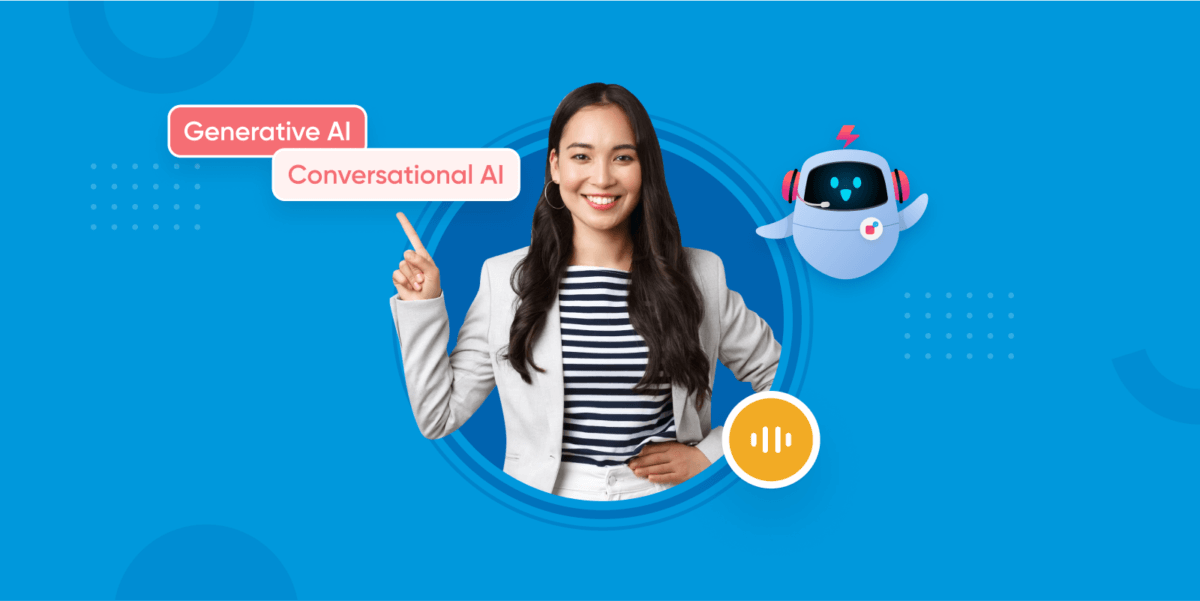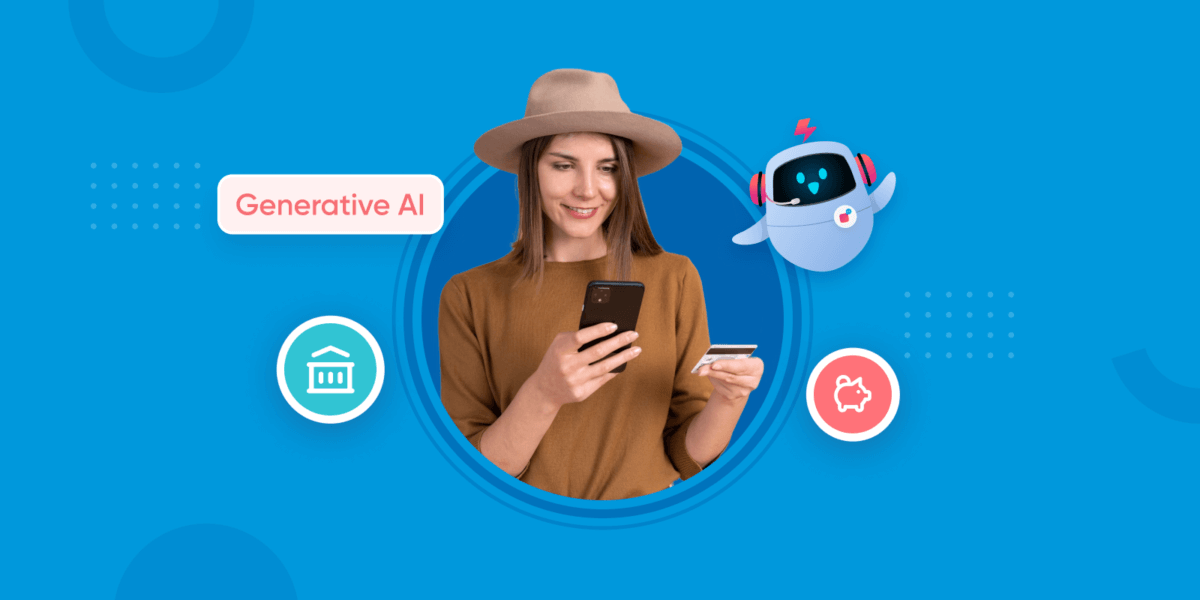Exploring How Generative AI and Conversational AI Intersect

Exploring How Generative AI and Conversational AI Intersect
Generative AI is at the vanguard of technological evaluations of recent developments in artificial intelligence, which have provided companies with powerful capabilities that can optimise their operations, making them more efficient and productive. Our world of business has undergone this transformation since the recent boom of ChatGPT and DALL-E.
Just picture the exciting potential when Generative AI and Conversational AI team up to transform how businesses work. Although we’re still in the early stages of using them, two important AI areas have emerged: Conversational AI, which creates natural conversations, and Generative AI, which generates new content from prompts.
Both wield powerful capabilities that can supercharge business operations, but a practical approach entails acknowledging that complete reliance on these technologies is unrealistic.
This article discusses the correlation and differences between conversational and generative AI, as well as how they converge.
But before we dive into the correlation, let’s first understand what Generative AI and Conversational AI stand for and the benefits they can bring to your business.
What is Generative AI?
Generative AI is an innovative form of artificial intelligence technology that can create various forms of content, including text, imagery, audio, and synthetic data. There is currently a lot of interest surrounding ChatGPT (short for Generative pre-trained Transformer). It’s an open-source chatbot that can provide an answer to almost any question it’s asked. Created by OpenAI and made available for testing to the public in November 2022, it is already being hailed as the top AI chatbot.
The purpose of generative AI is to allow machines to generate unique content by utilizing a combination of its training data and user input.
Sophisticated machine learning frameworks such as generative adversarial networks (GANs) and transformer models like GPT-4 (which stands for generative pre-trained transformer) are used in generative AI. Generative AI systems can automate time-consuming tasks, improve efficiency, and generate creative ideas to express a brand. However, they are not a guaranteed solution for business success. They can creatively produce original, authoritative, and human-like content. OpenAI’s ChatGPT serves as a great example of a generative AI model that generates text that can be mistaken for human interaction.
What is Conversational AI?
Conversational AI allows machines to communicate with human-like language, making interactions feel like you’re talking with a real person. This technology is used in chatbots, virtual assistants, and messaging apps to assist users, improve the customer experience, and simplify business processes while making the interface easier to use.
You might have already gotten a hang of conversational AI if you’ve used Siri, Alexa, or Google Assistant.
Verloop.io is one of the most prominent examples of the practical applications of AI models like Conversational AI and Generative AI in today’s era. It utilises a natural conversational language model to generate human-like responses. This AI is trained by using vast amounts of human dialogue data, which it analyses using techniques such as natural language processing (NLP), natural language understanding (NLU), and natural language generation (NLG).
Key Components of Generative AI And What It Means For Your Business
Generative AI is a branch of artificial intelligence that creates original content using algorithms and models. Here are its key components.
The key components of Generative AI include:
- Training Data: Generative AI models require a large dataset to learn from. This dataset can be text, images, or any other form of data that the model will generate content.
- Generative Models: These models are responsible for generating new content based on the patterns and structures learned from the training data. Examples of generative models include recurrent neural networks (RNNs), generative adversarial networks (GANs), and transformer models.
Now, let’s discuss how Generative AI models like GPT-3 and its successors work!
GPT-3 (Generative Pre-trained Transformer 3) is a state-of-the-art generative AI model developed by OpenAI. It works based on a transformer architecture, which allows it to process and generate text at an impressive scale. GPT-3 has been trained on a massive amount of text from various sources, such as books, articles, and websites.
When given a prompt or input, GPT-3 uses its vast knowledge of language and common patterns to generate a response or continuation that is coherent and contextually relevant. The model uses attention mechanisms to understand the relationships between words and generate realistic and human-like responses.
Real-world applications of Generative AI span across different domains.
Here are a few examples:
1. Content Generation
Generative AI helps create engaging content for articles, stories, and answering user queries, automating content creation with supplementary insights, tips, and examples.
2. Language Translation
Generative AI models translate languages accurately by understanding source language context, making them valuable for multilingual tasks.
3. Text Summarisation
Generative AI condenses lengthy texts into informative summaries, particularly useful for news articles and research papers.
4. Art and Design
Generative AI fosters creativity by generating unique artworks, designs, and music, offering new possibilities for artists and designers.
5. AI Powered Solutions and Virtual Assistants
Generative AI powers AI solutions like chatbots and virtual assistants, crafting human-like responses for customer support, personal assistance, and more.
6. Recommendation Systems
Generative AI personalised product recommendations based on user preferences and history, enhancing user experiences and engagement.
7. Data Augmentation
Generative AI generates synthetic data for machine learning, addressing data scarcity and improving AI system performance.
8. Virtual Worlds and Simulations
Generative AI creates lifelike virtual environments for gaming, training simulations, and virtual reality, elevating immersion and realism.
The Evolution of AI-Based Solutions & Virtual Assistants: From Rule-Based Systems to Advanced AI!
It’s amazing to see how much chatbots and virtual assistants have developed since they were first introduced. Although there are varying opinions on the size of the conversational AI market, it’s still relatively new. According to a recent estimate, the global conversational AI market was valued at approximately $5 billion in 2020. It’s projected to reach $14 billion by 2025 with a CAGR of 22%, as per Accenture.
What started as simple rule-based systems have evolved into sophisticated artificial intelligence (AI) algorithms that can understand natural language, learn from user interactions, and provide personalised assistance. Here we highlight the key milestones and advancements that have shaped their capabilities.
1. Rule-Based Systems
The early days of chatbots were dominated by rule-based systems. These systems followed predefined rules and decision trees to provide responses based on specific keywords or patterns. While they served as a starting point for the development of more intelligent conversational agents.
2. Natural Language Processing (NLP)
The introduction of natural language processing (NLP) marked a significant milestone in the evolution of chatbots and virtual assistants. NLP allows systems to understand and interpret human language, enabling more natural and intuitive interactions. With the help of algorithms like sentiment analysis by understanding the emotional tone of the message and named entity recognition (NER), chatbots became better equipped to understand user intent and provide appropriate responses.
3. Machine Learning and AI
With the advent of machine learning and AI, chatbots gained the ability to learn from user interactions and improve over time. Instead of relying solely on predefined rules, these systems utilised algorithms like deep learning and reinforcement learning to analyse vast amounts of data and adapt their responses accordingly. This led to a substantial improvement in the overall user experience.
4. Contextual Understanding and Personalisation
Modern chatbots and virtual assistants have become adept at understanding context and personalising interactions. By leveraging techniques like context-aware modelling and contextual embeddings, they can maintain conversation history and provide more relevant and personalised responses. These advancements have made chatbots feel more human-like and have enhanced their ability to assist users effectively.
5. Integration with Voice Assistants and IoT
The integration of chatbots with voice assistants, such as Amazon Alexa and Google Assistant, has opened up new possibilities for virtual assistance. Users can now interact with chatbots through voice commands, making the experience even more seamless and convenient. Additionally, chatbots have expanded their presence in the Internet of Things (IoT) domain, enabling users to interact with them through various smart devices, further integrating them into everyday life.
The evolution of chatbots and virtual assistants from rule-based systems to advanced AI has been a transformative journey. With query Reformulation and Refinement in NLP, machine learning, and AI algorithms, these intelligent conversational agents have become more intelligent, context-aware, and personalised. They are now capable of understanding natural language, learning from user interactions, and integrating with various technologies.
What Is the Role of Conversational AI in Modern Communication?
1. Enhancing Customer Support
Conversational AI enables businesses to provide round-the-clock customer support through chatbots and virtual assistants.
2. Streamlining Information Retrieval
Conversational AI can quickly and efficiently retrieve information from databases or knowledge bases, saving time and effort for users.
3. Automating Routine Tasks
Conversational AI can automate routine tasks, such as appointment scheduling, order tracking, and ticket booking.
4. Personalised User Experience
Conversational AI systems can understand user preferences, history, and context.
5. Language Translation and Localisation
Conversational AI can bridge language barriers by providing real-time translation and localization services.
6. Voice Interaction and Voice Assistants
Conversational AI enables voice-based interaction through voice assistants like Amazon Alexa, Google Assistant, and Apple Siri.
7. Improving Accessibility
Conversational AI technology plays a crucial role in improving accessibility for individuals with disabilities.
8. Data Analysis and Insights
Conversational AI systems can analyse and interpret user interactions, providing valuable insights into user behaviour, preferences, and needs.
Suggested Reading: The Role of LLM Bots to Empower Conversational AI Solutions
The Difference Between Conversational AI and Generative AI
1. Input and Output
Conversational AI relies on user input in the form of natural language queries or commands, and it generates responses or actions based on that input. Generative AI, in contrast, generally takes existing data or prompts as input and generates new content or outputs based on that input.
2. Purpose
Conversational AI focuses on enabling natural and human-like communication between machines and humans, to provide assistance, support, or information. Generative AI, on the other hand, aims to generate new and original content, such as text, data, and images, that mimics human creativity.
3. Abilities
Generative AI has a wider range of content creation abilities compared to conversational AI, which is only capable of understanding the emotional tone of the messages and responding to human language.
- Interaction
Conversational AI involves two-way communication between the system and the user, with a focus on understanding and responding to user queries and requests. Generative AI, on the other hand, is primarily focused on generating outputs without direct interaction with users.
- Implementation (H3)
Conversational AI platform helps in creating chatbots, virtual assistants, or voice-based assistants like Siri or Alexa. It involves natural language processing (NLP) techniques and machine learning algorithms to process and understand user input. Generative AI, on the other hand, typically involves deep learning models, such as recurrent neural networks (RNNs) or generative adversarial networks (GANs), to generate new content.
- Nature of Realism & Creativity (H3)
Conversational AI aims to simulate human-like responses, while generative AI aims to create content with a focus on originality and innovation.
- Applications (H3)
Conversational AI finds its applications in customer support, virtual assistants, chatbots, and other user-centric interactions that require real-time communication and assistance. Generative AI, on the other hand, finds applications in content generation (text, images, music), artistic creations, and creative industries.
Applications of Generative AI and Conversational AI
While both Conversational AI and Generative AI fall under the umbrella of artificial intelligence, their primary objectives, modes of interaction, and applications differ significantly. Conversational AI revolves around enabling effective communication with users, whereas Generative AI focuses on the generation of original content. Let’s see the synergic applications of Conversational AI and Generative AI.
Applications of Generative AI
1. Content Generation
Generative AI models are used to generate a wide range of creative content, including text, images, music, and even videos. These models can be employed in various industries such as advertising, entertainment, and design, where the need for fresh and innovative content is high.
2. Art and Design
Generative AI has found its place in the art world, where algorithms can create unique and visually stunning artworks. Artists can use these models as tools for inspiration, exploration, and collaboration, pushing the boundaries of creativity.
3. Gaming
Generative AI is used in game development to create interactive and dynamic environments, characters, and storylines. By generating realistic and intelligent responses, it enhances the gameplay experience, making it more immersive and engaging for players.
4. Music Composition
Generative AI models can compose original music by learning patterns from vast musical datasets. They are capable of generating melodies, harmonies, and even entire compositions that resonate with human listeners, opening up new possibilities for musicians and composers.
5. Data Augmentation
Generative AI can be used to create synthetic data for training machine learning models. Generating additional samples helps in addressing data scarcity issues and improves the performance and robustness of AI systems.
Applications of Conversational AI
1. Customer Support
Conversational AI powers chatbots and virtual assistants that provide instant and personalised support to customers. These AI-powered systems can answer queries, provide recommendations, and guide users through troubleshooting processes, improving customer satisfaction and reducing the need for human intervention.
2. Voice Assistants
Conversational AI is at the core of voice assistants like Amazon Alexa, Google Assistant, and Apple Siri. These intelligent assistants assist users in performing tasks, answering questions, and controlling smart devices using voice commands, making daily life more convenient and interactive.
3. Personalisation and Recommendations
Conversational AI can understand user preferences, capture context, and provide personalised recommendations. By analysing user behaviour and historical data, it can offer tailored content, product suggestions, and recommendations across various domains, from entertainment to e-commerce.
4. Information Retrieval
Conversational AI systems can retrieve information from vast databases or knowledge bases. Users can ask questions in natural language, and the systems can provide relevant and accurate answers, streamlining the process of finding information and reducing the need for manual search.
5. Language Translation and Localisation
Conversational AI technology enables real-time language translation, breaking down language barriers and enabling effective communication between users who speak different languages. Conversational AI-powered translation systems can facilitate multilingual conversations, cross-cultural communication, and international collaboration.
Verloop.io: Your Gateway to AI-Driven Excellence
The correlation between Generative AI and Conversational AI opens up a world of possibilities for businesses. These technologies, when integrated intelligently, can drive creativity, enhance efficiency, and elevate customer engagement. Verloop.io is a shining example of how AI models like Conversational AI and Generative AI are practically applied in today’s business landscape. With its advanced conversational language model, Verloop.io is positioned to redefine customer interactions and support.
So, don’t miss the opportunity to unlock the full potential of your business with Verloop.io. Schedule a demo today and witness firsthand how Generative AI and Conversational AI can transform your business into a powerhouse of innovation and customer satisfaction. Your future success awaits you on the other side.






